

/en/access2010/sorting-and-filtering-records/content/
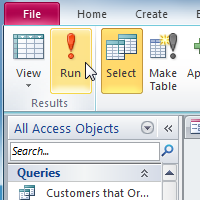
The real power of a relational database lies in its ability to quickly retrieve and analyze your data by running a query. Queries allow you to pull information from one or more tables based on a set of search conditions you define.
In this lesson, you will learn how to create a simple one-table query. Then you will learn how to plan and run a slightly more complex multi-table query.
Queries are a way of searching for and compiling data from one or more tables. Running a query is like asking a detailed question of your database. When you build a query in Access, you are defining specific search conditions to find exactly the data you want.
Queries are far more powerful than the simple searches or filters you might use to find data within a table. This is because queries can draw their information from multiple tables. For example, while you could use a search in the customers table to find the name of one customer at your business or a filter on the orders table to view only orders placed within the past week, neither would let you view both customers and orders at once. However, you could easily run a query to find the name and phone number of every customer who's made a purchase within the past week. A well-designed query can give information you might not be able to find out simply by examining the data in your tables.
When you run a query, the results are presented to you in a table, but when you design one you use a different view. This is called Query Design view, and it lets you see how your query is put together.
Click the buttons in the interactive below to learn how to navigate the Query Design view.

Entering query criteria lets you specify exactly what type of information you want your query to retrieve. Simply type the desired criteria in the Criteria: row of the field you want to search.
Here, the criteria have been set so the query will search for records with "Raleigh" in the City field and zip codes that are not "27610", "27615", or "27616" in the Zip Code field.

You may want to include fields in the design of your query but hide them in the query results. To hide a field, simply uncheck the check box in the Show: row of that field.
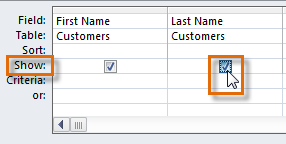
You can sort the data retrieved by a query. Simply click in the Sort: row of the field you want to sort and select either an Ascending or Descending sort. By default, query results are not sorted.

The first row of the design grid contains the names of the fields included in the query. Directly beneath each field name is the name of the table the field belongs to.
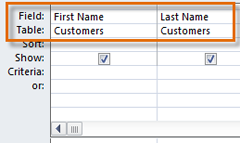
The bottom part of Query Design view is called the design grid. It contains a table that lists all the fields included in the query. Within this table, you can set criteria to specify which information the query should retrieve.

All of the tables you choose to include in your query will appear as small windows in the Object Relationship pane. Each window contains a list of every available field within that table.
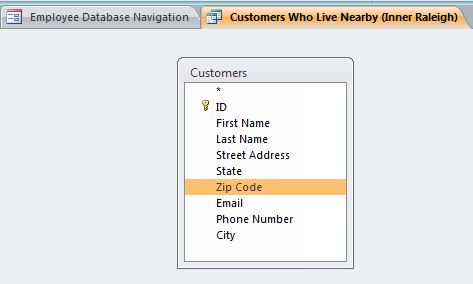
After you have designed your query, click the Run Query command to view the results of the query in a table.
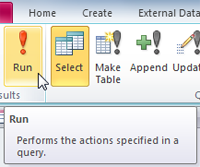
Click the View drop-down arrow to switch to another view of your query. In most cases, you will only need to use two main views: Datasheet View and Design View.
Datasheet View lets you view your query results in the form of a table. Design View, featured here, allows you to view and modify the design of your query.
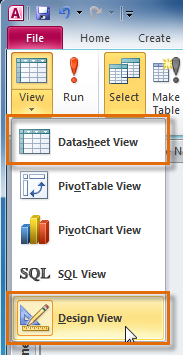
Let's familiarize ourselves with the query-building process by building the simplest query possible: a one-table query.
We'll run a query on the Customers table of our bakery database. Let's say our bakery is having a special event, and we want to invite our customers who live nearby because they are the most likely to come. This means we need to see a list of all of the customers who live close by — and only those customers.
If you think this sounds a little like applying a filter, you're right. A one-table query is actually just an advanced filter applied to a table.
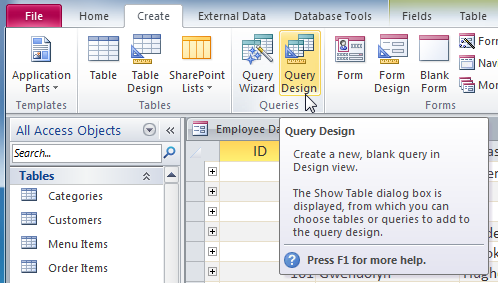 The Query Design Command
The Query Design Command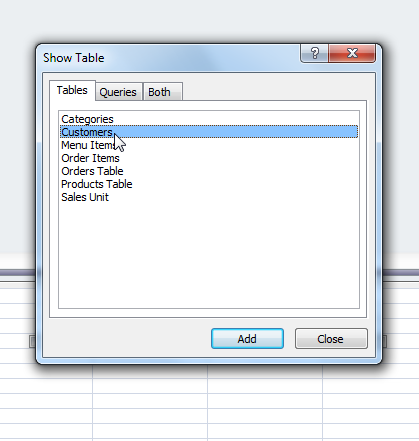 Selecting a table to use in the query
Selecting a table to use in the query Selecting fields to add to the query
Selecting fields to add to the query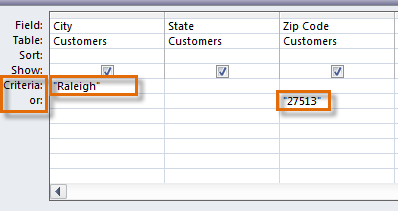 Setting the search criteria so that the query will find records with either "Raleigh" in the City field or "27513" in the Zip Code field.
Setting the search criteria so that the query will find records with either "Raleigh" in the City field or "27513" in the Zip Code field.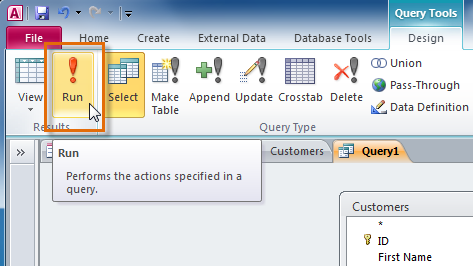 The Run Query command
The Run Query command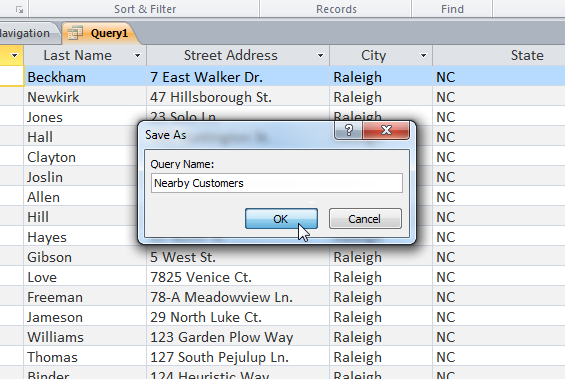 Naming the new query to save it
Naming the new query to save it
Queries can be difficult to understand and build if you don't have a good idea of what you're trying to find and how to find it. A one-table query can be simple enough to make up as you go along, but to build anything more powerful you'll need to plan the query in advance.
When planning a query that uses more than one table, take these four steps:
This process might seem abstract at first, but as we go through the process of planning our own multi-table query you should start to understand how planning your queries can make building them a lot easier.
Let's go through this planning process with a query we'll run on our bakery database. As you read through the planning process step by step, think about how each part of the planning process could apply to other queries you might run.
Our bakery database contains many customers, some of whom have never placed an order but who are in our database because they signed up for our mailing list. Most of them live within the city limits, but others live out of town or even out of state! We want to get our out-of-town customers who've placed orders in the past to come back and give us another try, so we're going to mail them some coupons. We don't actually want our list to include customers who live too far away; sending a coupon to someone who doesn't live in our area probably won't make them come in. So really, we just want to find people who don't live in our city but who still live in our area.
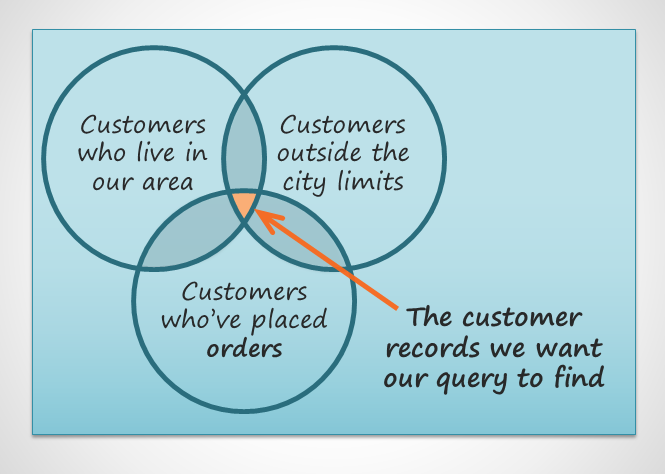 Identifying the data we want the query to find
Identifying the data we want the query to findIn short, the question we want our query to answer is this: Which customers live in our area, are outside the city limits, and have placed an order at our bakery?
What information might we want to see about these customers? Obviously, we'll need the customers' names and their contact information—their addresses, phone numbers, and email addresses. But how are we going to know if they've placed orders? Each record of an order identifies the customer who placed that order. If we include the order ID numbers, we should be able to narrow our list down to only customers who have previously placed orders.
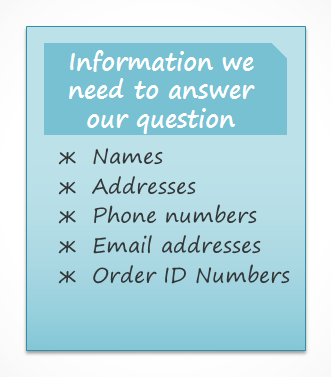 Making a list of the information we want the query to find
Making a list of the information we want the query to findIn order to write a query, you need to be pretty familiar with the different tables in your database. From working extensively with our own database, we know the customer information we need is located in fields in the Customers table. Our Order ID numbers are in a field in the Orders table. We only need to include these two tables to find all of the information we need.
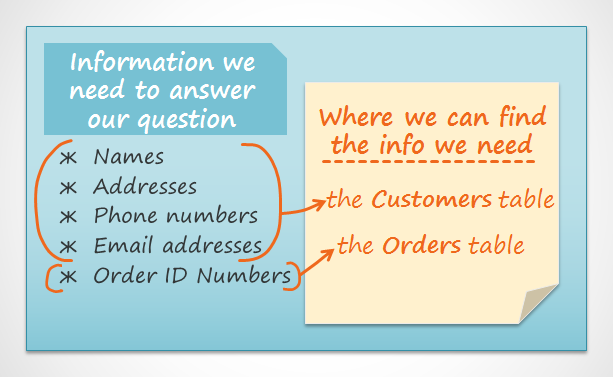 Making a list of the tables where we can find the information we need for our query
Making a list of the tables where we can find the information we need for our queryWhen you set criteria for a field in a query, you are basically applying a filter to it that tells the query to retrieve only information that matches your criteria. Review the list of fields we are including in this query. How and where can we set criteria that will best help us answer our question?
We don't want customers who live in our town, Raleigh, so we want a criteria that will return all records except those with Raleigh in the city field. We don't want customers who live too far away, either. All phone numbers in the area start with the area code 919, so we'll also include a criteria that will only return records whose entries from the phone number field begin with 919. This should guarantee that we'll only send coupons to customers who live close enough to actually come back and use them.
We won't set a criteria for the order ID field or any other fields because we want to see all of the orders made by people who meet the two criteria we just set.
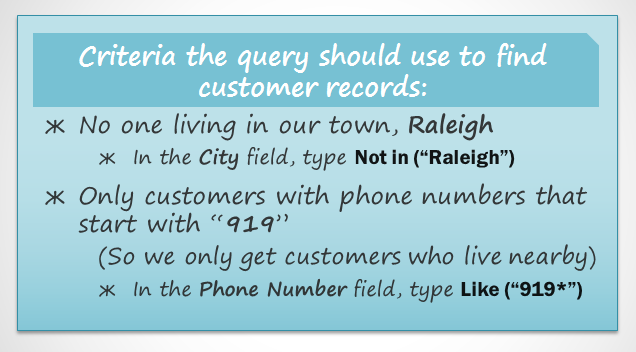 Figuring out the criteria we will use to build our query
Figuring out the criteria we will use to build our queryTo write queries, you'll need to be able to set criteria in a language Access understands. As you can see in the image above, our criteria requiring phone numbers to begin with 919 must be typed like this: Like ("919*"). To learn how to write additional criteria, consult our printable Query Criteria Quick Reference Guide in the Extras section of this tutorial. The guide includes several of the most commonly used criteria in Access queries.
The final thing you need to consider when designing a query is the way you link—or join—the tables you're working with. When you add two tables to an Access query, this is what you'll see in the Object Relationship pane:
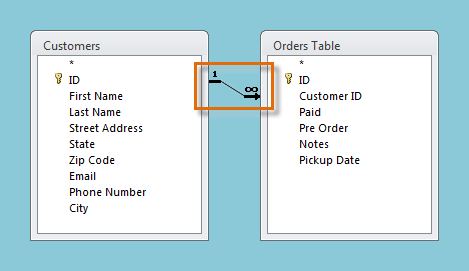 Joined tables in the Object Relationship Pane
Joined tables in the Object Relationship PaneThe line connecting the two tables is called the join line. See how the join line is actually an arrow? This is because it indicates the order in which the query looks at data from the two tables. In the image above, the arrow is pointing from left to right, which means the query will look at data in the left table first, then only the data in the right table that relates to the records it's already seen in the left table.
Your tables won't always be joined this way—sometimes Access will join them right to left. In either case, you might need to change the direction of the join to make sure your query includes the correct information. The join direction can affect which information your query retrieves.
To understand what this means, consider the query we're designing. For our query, we need to see customers who have placed orders, so we've included the Customers table and the Orders table. Let's take a look at some of the data contained in these tables.
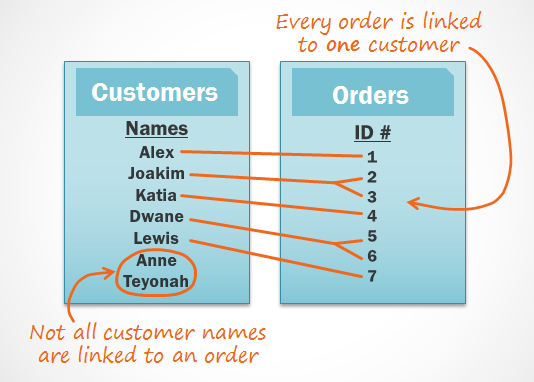 Related data stored in the Customers and Orders tables
Related data stored in the Customers and Orders tablesWhat do you notice when you look at these lists? Every single order in the Orders table is linked to someone in the Customers table—the customer who placed that order. However, when you look at the Customers table, you'll see that the customers who've placed multiple orders are linked to more than one order, and those who've never placed an order are linked to no orders. As you can see, even when two tables are linked it's possible to have records in one table that have no relationship to any record in the other table.
So what happens when Access tries to run our query with the current join, left to right? First, it pulls every record from the table to the left: our Customers table.
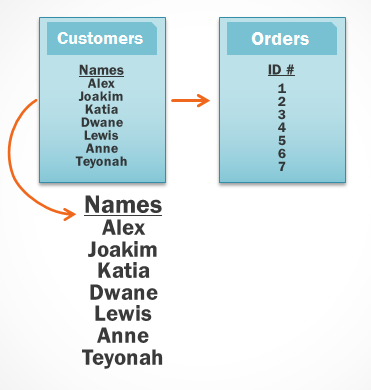 The Left to Right join retrieves all the records from the table on the left first.
The Left to Right join retrieves all the records from the table on the left first.It then retrieves every record from the right table that has a relationship with a record Access has already taken from the left table.
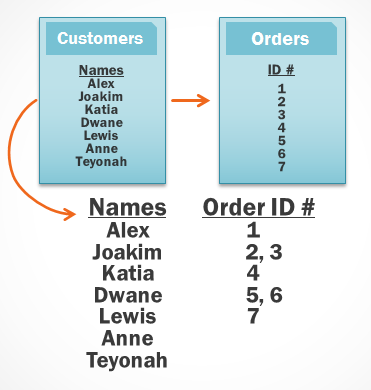 The query then retrieves the orders linked to the customer records it already pulled. These are the records the query will draw its information from.
The query then retrieves the orders linked to the customer records it already pulled. These are the records the query will draw its information from.Because our join began with the Customers table, our query will include records for all of our customers, including those who've never placed orders. This is way more information than we want! We only want to see records for customers who have placed orders.
Fortunately, we can fix this problem by changing the direction of the join line. If we join the tables from right to left instead, Access will first retrieve all of the orders from the right table, which is our Orders table:
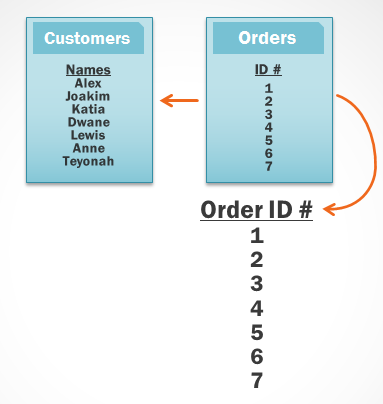 The Right to Left join retrieves all the records from the table on the right first.
The Right to Left join retrieves all the records from the table on the right first.Then Access will look at the left table and retrieve only the records of customers who are linked to an order on the right.
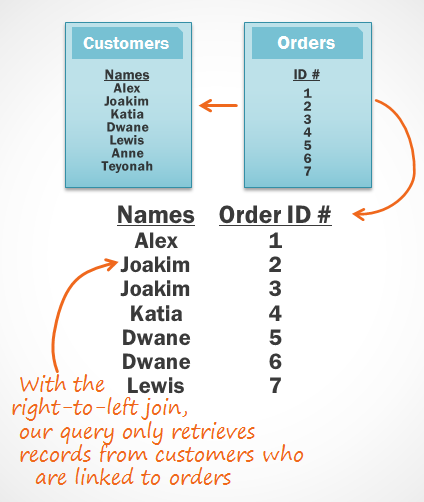 Next, Access retrieves only the records from the left table that are linked to existing orders from the right. These are the records the query will draw its information from.
Next, Access retrieves only the records from the left table that are linked to existing orders from the right. These are the records the query will draw its information from.We now have exactly the information we want: all of the customers who have placed an order, and only those customers. As you can see, we had to join our tables in the correct direction to obtain the information we wanted.
Now that we understand which join direction we need to use, we're ready to build our query!
In our query, we needed to use the right-to-left join, but the correct join direction for the tables in your queries will depend on what information you want to see and where that information is stored. When you add tables to a query, Access will automatically join the tables for you, but it often doesn't join them in the correct direction. This is why it's important to always review the joins between your tables before building a query.
Now that we've planned our query, we're ready to design and run it. If you have created written plans for your query, be sure to reference them often throughout the query design process.
 The Query Design Command
The Query Design Command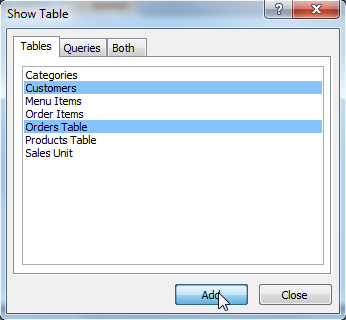 Selecting tables to use in the query
Selecting tables to use in the query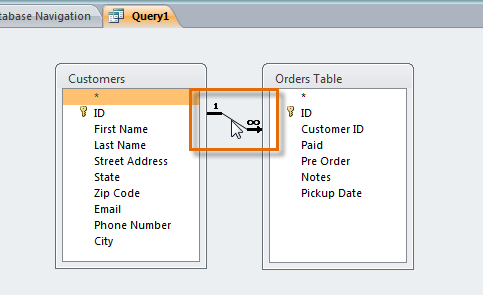 Clicking the join line to edit its direction
Clicking the join line to edit its direction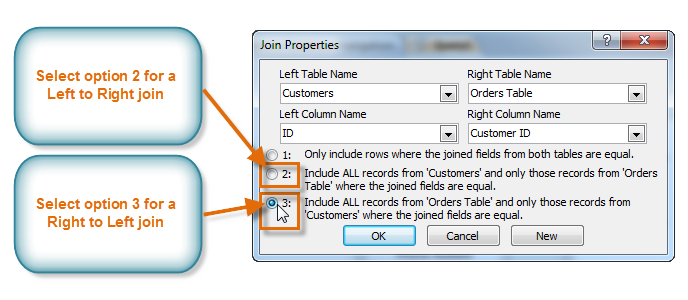 Changing the join direction to Right to Left
Changing the join direction to Right to Left
In our example, we'll include most of the fields from the Customers table: First Name, Last Name, Address, City, State, Zip Code, and Phone Number. We'll also include the ID number from the Orders table.
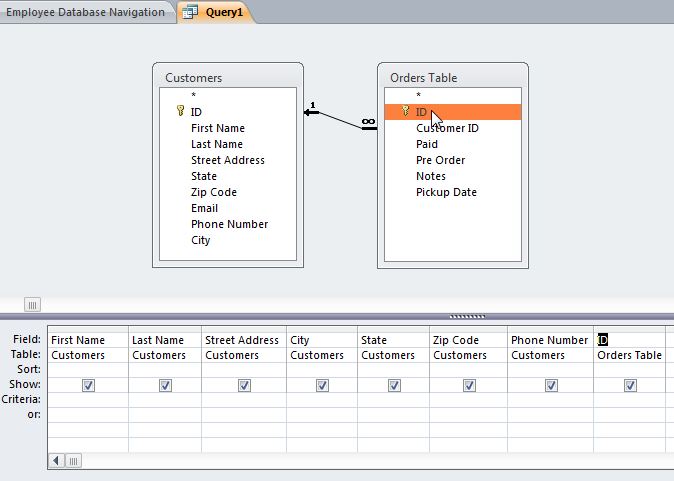 Adding table fields to the query
Adding table fields to the query Setting field criteria
Setting field criteria 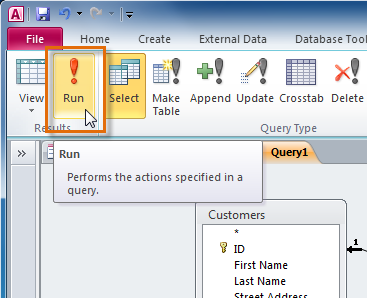 Selecting the Run command
Selecting the Run command Naming the new query to save it
Naming the new query to save it
/en/access2010/more-query-design-options/content/